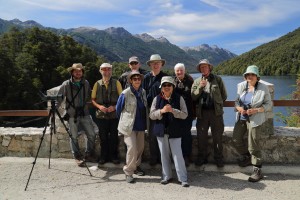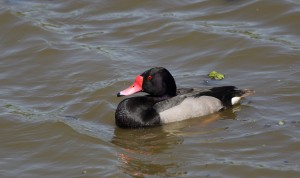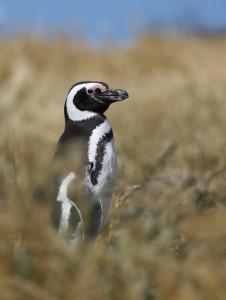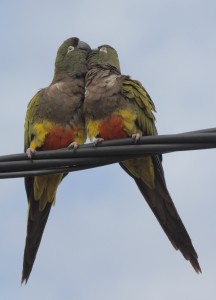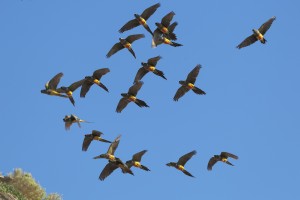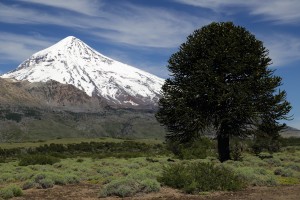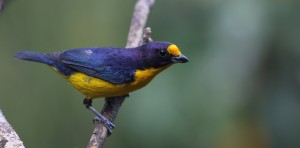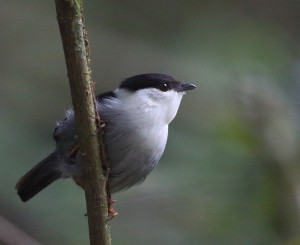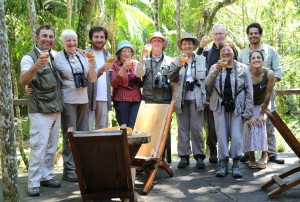We leave a cold grey November day back home, for a warm blue sky over Buenos Aires, where early birds include Moorhen, Starling and House Sparrow! While eating a picnic lunch on a wall, with towering skyscrapers and a steady stream of traffic on one side, a steady stream of exotic water birds on the other includes Rosy-billed Pochard, Coscoroba Swan, Speckled and Silver Teal, White-faced Whistling-duck, Pied-billed, White-tufted and Great Grebes, Red-gartered and Red-fronted Coots, Great Egret, Cocoi and Whistling Herons, Snail Kite, Southern Lapwing, Lesser Yellowlegs, Wattled Jacana, Ringed Kingfisher and the strange Limpkin. An hour or more passes and we have barely moved an inch, while adding many more species to the list such as Southern Caracara, Harris’ Hawk, Eared Dove, Picazuro Pigeon, Black-hooded Parakeet, Guira Cuckoo, Shiny, Bay-winged and Screaming Cowbirds, Great Kiskadee, White-rumped and Blue-and-white Swallows, Grey-breasted and Brown-chested Martins, Chalk-browed Mockingbird, House Wren, Red-crested Cardinal, a posing Glittering-bellied Emerald and Rufous Hornero, Argentina’s national bird. After almost two hours on one spot we enter the Costanera Sur reserve, on the very edge of this great capital city, where a Chimango Caracara is stripping flesh from the bones of a hapless chick. New ticks right next to the track here include Monk Parakeet, Small-billed Elaenia, Green-barred Woodpecker, Creamy-bellied and Rufous-bellied Thrushes, Unicoloured Blackbird, Chivi Vireo, White-lined Tanager, Masked Yellowthroat, Hooded Siskin, Rufous-collared Sparrow, and a very tame Golden-billed Saltator, while a Grey-necked Wood-rail crosses the path straight ahead. Meanwhile, a scan of the marsh reveals Black-necked Swan, Brazilian Duck, South American Stilt, Spot-flanked Gallinule, Tropical Kingbird and Yellow-winged Blackbird. Not a bad list for an afternoon stroll in a ‘big city park’.
The welcoming words Croeso and Bienvenido are not normally seen together, but here we are in ‘Welsh’ Patagonia, after a flight south from Buenos Aires to Trelew. The air is noticeably cooler but the sky is still blue as we head to the southernmost point of our trip at Punta Tombos, where we are greeted by tame Rufous-collared Sparrows, Scale-throated Earthcreeper and the comical sight of a stocky Magellanic Penguin waddling along a boardwalk, leading us to the sea over a mile away! We soon encounter more penguins, many in shallow burrows, dotted incongruously across the arid semi-desert scrub in their tens of thousands! This is the largest colony of these penguins in the world! Along the boardwalk, we also spot several darting Sharp-billed Canasteros, shiny blue Southern Martins, a very striking Spectacled Tyrant and a trio of Elegant Crested Tinamous at incredibly close range, while mammal sightings include numerous Guanacos, which are attractive members of the Camel family, and a Hairy Armadillo scurrying among the penguins. Down on the shore there are penguins playing in the surf, while an equally flightless Chubut Steamer-duck is relaxing on the beach, with Kelp Gulls and impressive Southern Giant Petrels patrolling just offshore. Other sightings here include Grey-headed Sierra-finch, Blackish Oystercatcher and Royal and South American Terns. On the way back along the boardwalk, we find our first Lesser Rhea, another flightless bird, and enjoy close views of Patagonian Yellowfinch. Heading north along the coast to Isla Escondida, we find a small group of young Elephant Seals, accompanied by an awesome fully grown battle-scarred bull, growling grumpily at the young upstarts. Nearby we spot Black-chested Buzzard-eagle and our first Maras, which are large rodents resembling a cross between a hare and a kangaroo!
Leaving Puerto Madryn at 6am, we start off with close views of Austral and Chiguanco Thrushes, which are garden birds here, followed by a Variable Hawk on a roadside telegraph pole, not far out of town on the road to the Valdés peninsula, where we find Magellanic, Imperial and Neotropic Cormorants on the rocky shore, along with Dolphin Gulls, Blackish and American Oystercatchers, a group of South American Sea Lions and the strange Snowy Sheathbill, which looks like a cross between a pigeon and a chicken! Way out in the calm bay off Punta Pardelas we find mother and calf Southern Right Whales, and each time the mother surfaces, we can all see the extensive encrustations of barnacles all over her enormous head; a real wow moment. The nearby aptly named ‘Bird Island’ is absolutely plastered with thousands of Magellanic Cormorants and Kelp Gulls, with Crested Ducks, Flying Steamer-ducks and a flock of Grassland Yellowfinches along the shore, while exploration of the hinterland produces more Guanacos and Maras, plus good views of Turkey Vulture, Patagonian Mockingbird, Lesser Shrike-tyrant, Long-tailed Meadowlark, Common Diuca-finch, Mourning Sierra-finch and the striking endemic Rusty-backed Monjita. From here it’s a long drive north, along what must be one of the world’s longest straightest roads, through the seemingly endless Patagonian steppe, to Las Grutas, a small seaside town with a cliff-dwelling colony of noisy Burrowing Parakeets, which line up along the wires on the seafront.
Four Bottle-nose Dolphins, swimming just off the beach in front of the hotel first thing this morning, are a good omen for today’s pelagic trip, way out on San Antonio Bay, which is flat calm and sparkling bright blue. Heading out to sea, we pass a lively colony of South American Terns, and then a group of South American Sea Lions hauled out on a beach alongside a mix of Royal, South American and Cayenne Terns, as well as Brown-hooded Gulls. Further out we find the first of several rafts of Manx Shearwaters, which have met up with us here under their own steam all the way from the British Isles! Soon we have the first of at least six Black-browed Albatrosses very close to the boat, as well as Southern Giant and White-chinned Petrels right alongside! Cruising along, we are now joined by cream sided Common Dolphins, clearly visible below the surface, while surfing in the wake of the boat, riding the bow wave and leaping clear of the water all around us in countless numbers! The excitement rises to fever pitch as the skipper homes in on a remarkable feeding frenzy, sending cameras into overdrive, with so much action all around the boat. Even the skipper has his camera out! In the crystal clear water it is possible to see shoals of shiny Anchovies, circling beside the boat, while surrounded by a ‘boiling’ mob of Common Dolphins, Sea Lions, Magellanic Penguins, Manx Shearwaters, Black-browed Albatrosses, White-chinned Petrel, Wilson’s Storm-petrel and Kelp Gulls galore! The mayhem is pure magic and like a scene from The Blue Planet! Just when it can’t get any better than this, several Dusky Dolphins join the ‘fiesta’! Eventually, as the silver scales settle gently to the sea bed, we head back to shore, in a state of ecstatic disbelief at all that we have been lucky enough to see at such close range, and yet there is more to come as the skipper cuts the engine for a South American Fur Seal, scratching and rolling playfully on the surface like an overgrown Sea Otter. Back on track for the shore, Marcelo spots “large dolphins” in the distance, which immediately brings Orcas to mind. Yes indeed, as we close in, black bodies with white flanks and tall black dorsal fins are the unmistakable signs of an Orca mother and calf! These are joined by the towering sail-like dorsal fins of two males, one of which gets so close to the boat that we watch in amazement as he actually glides effortlessly through the clear blue water below the boat, before surfacing with a snort of his blowhole on the other side! His next move is even more remarkable as he shadows the boat just below the surface, revealing the full length of his black and white outline parallel with the boat and just yards away from us! What a spectacular and unforgettable experience, including four different cetaceans in one day!
After a late lunch of barbecued lamb, a stroll through the dry scrub produces top drawer birds like Cinereous Harrier, Fork-tailed and Vermillion Flycatchers, White-banded Mockingbird, Black-crowned Monjita, Hudson’s Black-tyrant, the endemic White-throated Cacholote and the elusive endemic Sandy Gallito, scurrying back and forth on the path just ten yards ahead! What a brilliant day.
Heading due east along the coast ‘road’, which is a simple dirt track, our first new sighting on this leisurely birding drive is a smart Campo Flicker on a roadside fence, followed by the endemic Carbonated Sierra-finch and an Elegant Crested Tinamou with seven crested chicks! A mid morning stop produces several Short-billed Pipits in song flight and also perched on fence posts, as well as Rusty-backed, Black-crowned and White Monjitas, all visible from the same spot! The lunch stop is also productive with close sightings of Straneck’s Tyrannulet, Tufted Tit-tyrant and the lovely White-tipped Plantcutter. Further on, a small pond offers Yellow-billed Pintail and Speckled Teal, and then a Burrowing Owl shows very well on top of a roadside bush. The strong wind makes for heavy weather through a particularly sandy stretch, and at one point we all have to get out of the minibus to lighten the load and help push it through the soft wind-blown sand. Moving on again, we make an emergency stop for a Darwin’s Tinamou crouching at the edge of the track, and again shortly after for a handy-sized Tarantula crossing the track! Next sighting is the first of many Greater Rheas, and this impressive father figure has around thirty scampering chicks in ‘tow’! Once the sand dunes are replaced by cliffs we enjoy an aerial display by a pair of Peregrine Falcons, near Punta Bermeja which is the largest Sea Lion colony in Patagonia, with thousands laid out along the beach below the cliffs, along with several Southern Giant Petrels and at least one Elephant Seal cow. Journey’s end is tiny El Cóndor, home of the world’s largest colony of Burrowing Parakeets, where the windswept cliff tops are alive with thousands of these colourful birds in noisy agitated flocks, creating another spectacular show.
With around 80,000 parakeets living ‘next door’ to the hotel, we begin with another visit to the cliffs, which are riddled with burrows as if the entire coastline has been strafed with heavy machine gun fire, and in a lifetime of birding this has to be one of the most remarkable spectacles I have ever seen! Moving on along the Rio Negro valley we spot more Maras, some with young, and add Spot-winged Pigeon and Long-winged Harrier to our growing list. Even well inland there are still wave after wave of the amazing Burrowing Parakeets returning home after foraging many miles away. A mid morning refueling stop adds two more new birds to the list; Picui Ground-dove and Stripe-crowned Spinetail in addition to ‘old favourites’ like Picazuro Pigeon, Brown-chested Martin, Chalk-browed Mockingbird, Great Kiskadee, Tropical Kingbird and Vermillion and Fork-tailed Flycatchers. Back on the road, four White-faced Ibises are next on the list. A picnic site beside the Rio Negro is a nice place for lunch along with Snowy Egret, Pied-billed Grebe, Monk Parakeet, Shiny and Bay-winged Cowbirds, Rufous Hornero, Swainson’s Flycatcher and Brown Cacholote, which builds an incredibly bulky nest for such a small bird. After lunch we meet up with local birder Milton for ‘Operation Yellow Cardinal’ and eventually some of us get a brief view of this increasingly rare bird, while other sightings here include Crested Gallito, Sharp-billed Canastero, Ringed and Cinnamon Warbling-finches, White-tailed Kite and a stunning Tawny-throated Dotterel posing in perfect light just ten yards away!
After an overnight coach ride with pillows, blankets and comfy reclining seats, we arrive in Nuequén, many miles to the west, and yet the Patagonian steppe continues to stretch for mile after mile after mile! Along the way we see our first Gauchos, and as the flat landscape and dead straight roads become more curvaceous, we reach the foothills of the Andes and see distant snow-clad peaks. By late morning we arrive at Laguna Solitaria, home to a good variety of birds including Chilean Flamingo, White-tufted Grebe, Black-necked and Coscoroba Swans, Yellow-billed Pintail, Chiloe Wigeon, White-winged and Red-gartered Coots, Collared and Two-banded Plovers, South American Stilt, Greater Yellowlegs, Sanderling, Baird’s Sandpiper, Brown-hooded Gull, Black Vulture, American Kestrel, Blue-and-white Swallow, Correndera Pipit and the delightful little Austral Negrito. At nearby Covunco, we enjoy scope views of Cinnamon Teal and White-faced Ibises, looking resplendent in the sunshine which brings out their iridescent sheen. Heading south along the valley of the Rio Collon Cura, we find Upland Geese, Yellow-winged Blackbird, Wren-like Rushbird, and the lovely little Many-coloured Rush-tyrant, as well as introduced Red Deer and Wild Boar, living alongside the native Guanaco. As the sun sinks towards the horizon and the shadows lengthen, awesome Andean Condors descend from the heavenly blue sky to roost on white-washed cliff ledges near San Martin de Los Andes, providing brilliant views in the scope and a marvelous finale to a long but productive day.
Yet again the sky is cloudless and blue this morning, as we head for a small nature reserve on the edge of town, where our target Grass Wren is ready and waiting with clear scope views, while there are plenty of other goodies to enjoy like Chiloe Wigeon, Yellow-billed Pintail, black-headed Ruddy-type Andean Ducks, Southern Lapwings, White-winged, Red-gartered and Red-fronted Coots, noisy Black-faced Ibises, Hellmayr’s Pipit, Wren-like Rushbird, White-crested Elaenia, a pair of showy Cinereous Harriers, obliging Chimango Caracaras and Spectacled Tyrants, and star of the show, several Many-coloured Rush-tyrants showing really well. After a picnic lunch by the river behind the hotel, a quick visit to the lakeshore on the edge of town adds Dark-bellied Cinclodes to the list, while a pair of Great Grebes, are performing their elegant courtship display with erected crests. From here a short drive leads into Lanin National Park, where we enjoy a leisurely walk around the superbly scenic Laguna Rosales, bathed in warm sunshine, with a family of Ashy-headed Geese with sixteen small goslings to complement the tranquil scene. The wet meadows beside the lake are grazed by a mixture of Upland and Ashy-headed Geese and Black-faced Ibises, while the adjacent woods produce Chilean Swallow, Tufted Tit-tyrant, White-throated Treerunner, Austral Blackbird, Black-chinned Siskin, a couple of Treecreeper-like Thorn-tailed Rayaditos dashing in and out of their nest holes and the aptly named Fire-eyed Diucon, with the most brilliant glistening red eyes imaginable. With beautiful scenery, warm sunny weather, good company and great birds, this was not a bad way to spend a typically cold grey damp British November day.
This is such a lovely climate, with another clear blue sky and more stunning scenery as we head north into Lanin National Park, with roadside stops along the way for California Quail and Great Shrike-tyrant, the largest of the Flycatcher family, capable of taking smaller birds with its formidable hooked beak! As the snow-clad cone of the Lanin volcano looms larger, ancient Monkey Puzzle trees add a touch of antiquity to this ‘new world’ landscape, and we marvel at the appearance of another magnificent Andean Condor. The forest at the foot of the Lanin volcano is home to the continent’s largest woodpecker, and as we follow the trail, freshly drilled finger deep holes are evidence of its presence. While Patagonian Sierra-finch and White-throated Treerunner are quickly found, the woodpecker is more elusive, until our guide starts tapping a staccato rhythm with a stone on a tree trunk. Soon after, the mighty Magellanic Woodpecker appears. This is a female with yellow eyes, red face and long forward curling crest, and she puts on a great show in the scope, while hammering seven bells out of a tree trunk! “Where is the male?” I jokingly ask our guide, and incredibly, within a few minutes we find him, showing off his bright red hood, equally obligingly as his partner. After a picnic lunch the woodpecker fest continues with a Striped Woodpecker, followed by Austral Parakeets and both Bar-winged and Dark-bellied Cinclodes near Tromen Lake.
Today we follow the magnificent ‘seven lakes’ route across the snow-capped Andes and into Chile, passing through stunning scenery, with occasional stops for photo-shoots and Rufous-tailed Plantcutter, with bright orange eyes. Once across the border, we enter the thickly forested Puyehue National Park, hoping to see some secretive tapaculos, but our first new tick is a very obliging male Green-backed Firecrown, a tiny hummingbird with a crown that glitters like fire from certain angles. After a short wait our next sighting is a Chucao Tapaculo, which pops out on a sunny log right in front of us! This must be special as it is the cover bird for the Birds of Chile fieldguide! A little further along the track, we connect with a tiny Magellanic Tapaculo which creeps to within a few yards of us before calling from a nearby perch in full view! By now we are on a roll and within minutes we spot a bulky dark bird with rusty crown and underparts and a large eye ring, scratching through the leaf litter beside the track. This is the Black-throated Huet-huet! What an amazingly productive short stroll.
This morning we take the ferry across to Chiloe Island, spotting Peale’s Dolphin, Sooty and Pink-footed Shearwaters and the recently discovered Pincoya Storm-petrel on the crossing. The plentiful birdlife along the shoreline of this very large island includes Black-necked Swan, Speckled Teal, Franklin’s Gull, Whimbrel, Knot, Hudsonian Godwit, two Least Sandpipers and a Snowy Plover amongst hundreds of Baird’s Sandpipers, plus Chiloe Wigeon of course, and the bizarre Black Skimmer, with its elongated lower mandible. A lucky few also get great views of Plumbeous Rail and glimpse the secretive Des Mur’s Wiretail deep within a bamboo clump. Inland, a small lake adds Silvery Grebe, Red Shoveller and the Ruddy Duck-like Lake Duck. From here we take a boat trip along the Rio Chepu and amongst the hundreds of nesting Brown-hooded Gulls, we find a pair of elegant Snowy-crowned Terns and several Coypu. Back on dry land we finally catch up with Chilean Pigeons, with vinaceous plumage and nice shiny bronze necks. After lunch with a wonderful panorama across a sandy bay with yellow lichens on the dark rocky headlands reminiscent of Devon or Pembrokeshire, except for the Peruvian Pelicans, we mount a trolley which tows us through the surf and onto a large inflatable boat. The ensuing joy ride produces more great birds like Magellanic and Humboldt Penguins, Flightless Steamer-duck, Neotropic, Magellanic, Imperial and really smart Red-legged Cormorants, Southern Giant Petrel, another Black-browed Albatross and pairs of Kelp Geese, with pure white males and smartly patterned females.
Today we leave the lush green pastures, grazed by dairy cattle and interspersed with scattered deciduous trees, on a flight from Puerto Montt to Santiago de Chile, where the dry rocky slopes are dominated by tall spiny cacti, used as vantage points by Chilean Mockingbirds. A Moustached Turca, with size 12 feet and endemic to these rocky slopes, poses nicely on rocks right next to the road, and after some 36 tortuous hairpin bends at an altitude of over 6,000 feet, we reach a magnificent view of the vertiginous Fallones valley, with five Condors soaring high above the snowy slopes. Other sightings include Mountain Caracara, White-browed Ground-tyrant, Greater Yellowfinch, plenty of Black-winged Ground-doves and a male White-sided Hillstar, with a fabulous glittering emerald gorget, and well worth the drive.
We have an early start for a flight from Santiago back to Buenos Aires, with an onward transfer north to Puerto Iguazu, where the sub-tropical rainforest at 30°C is yet another contrasting habitat, compared with the ‘big sky’ landscapes of Patagonia and the towering snow-capped Andean mountain range. At the airport, we are met by Chopi Blackbirds and a battered old 4 x 4, which ‘whisks’ us to the Hummingbird Garden in Iguazu town. The small back garden is buzzing with activity and in just a short while we marvel at close range views of seven different species of ‘hummers’; Black Jacobin, Black-throated Mango, Glittering-bellied and Versicoloured Emeralds, Violet-capped Woodnymph, and Gilded and Swallow-tailed Hummingbirds, plus Bananaquit, Ruddy Ground-dove, Blue Dacnis, Green-headed and Sayaca Tanagers, Shiny Cowbird and Saffron Finch. From here it’s a bone-shaking drive on a dirt track through Iguazu National Park, spotting a perched Rufous-thighed Kite en route to the really welcoming Surucuá Ecolodge.
This morning the forest is alive with the sounds of insects and birds, and while many are obscured by the foliage, good sightings include Grey-fronted Dove, Chestnut-eared Aracari, Magpie Tanager, Squirrel Cuckoo, the gorgeous Plush-crested Jay, and male White-bearded Manakins, which steal the show with their amazing buzzing and wing-snapping displays. Hefty inch-long and-a-bit Bullet Ants, which pack a serious punch, trundle purposefully across the trails, and on the way back to the lodge for a late breakfast, more new birds include Scaly-headed Parrot, Pale-breasted Thrush, Epaulet or Variable Oriole and the bright orange Band-tailed Manakin. A mid-morning stroll reveals a feast of colourful butterflies as well as Plumbeous Kite, Sooty-fronted Spinetail, Greater Ani and a pair of Surucua Trogons. Back at the lodge, Gary the resident Violet-capped Woodnymph, puts on a glittering display from his regular perch next to the verandah! After lunch and some well-earned siesta time, we find Boat-billed Flycatcher, Red-crowned Ant-tanager, a Common Pauraque showing well in the scope while sitting on the trail, and a Neotropic River Otter leaping playfully in the Rio Iguazu which marks the border with Brazil on the opposite side. Further on we are still finding new birds like Blue-winged Parrotlet, the rare White-bearded Antshrike and the superb Toco Toucan with an enormous incandescent orange bill.
We have a final pre-breakfast stroll before leaving the lovely Surucuá Lodge, and our first new bird of the day is a male Spot-backed Antshrike singing in the scope, quickly followed by Black-goggled Tanager. Next we play hide and seek with a tail-swinging Rufous Motmot, which most manage to see, while all get good views of Eared Pygmy-tyrant, graceful Swallow-tailed Kites and a baby-carrying mother Tufted Capuchin Monkey. Back at the lodge, White-eyed Parakeets are waiting patiently and Gary is back on his perch! Sadly, it’s time to leave this ‘home from home’ and move on, breaking the journey for Roadside Hawk, Black-tailed Tityra, Smooth-billed Ani and a rufous-headed Burrowing Owl, having a rest from digging in the red soil. We arrive at Karadya Lodge in time for lunch with the fans on full blast, followed by a long rest on the terrace with limited bird activity due to the unusually hot weather, but new sightings include Scale-throated Hermit, Black-breasted Plovercrest and a bombshell Blond-crested Woodpecker. By 4.30pm the temperature is still unusually high and the birds are still quiet but we do manage to see Ruby-crowned Tanager, Variegated, Streaked and Social Flycatchers and the miniscule Ochre-collared Piculet, which at a length of less than 4 inches, is a mere fraction of the size of the Magellanic Woodpecker! By evening the air has cooled and the clear dark sky is ideal for watching fireflies, and stargazing, with Venus and Mars visible in the scope, while Orion is standing on his head.
Dark clouds, thunder and lightning first thing this morning, are a stark contrast to yesterday’s clear blue sky, and before long we need our rain gear for the first time on the trip. A White Woodpecker shows well in the scope, en route to the Rio Uruzu in the nearby Uruguai Provincial Park, where the target bird is Black-fronted Piping-guan, and after a few brief glimpses we all get great views of this large turkey-like bird, firstly sitting in a tree top and then paddling in the river! Meanwhile other good sightings here include White-browed and River Warblers, Red-rumped Cacique, Piratic Flycatcher, White-winged Becard, Swallow Tanager and Double-collared Seedeater. After lunch back at the lodge, the activity this afternoon shows just how quiet yesterday was, with a steady flow of birds in a short stroll of little over an hour; 2.40pm, Buff-browed Foliage-gleaner, 2.45, Yellow Tyrannulet, 2.50, Sepia-capped Flycatcher, 2.55, male Blue Manakin, 3pm, female Plain Antvireo, 3.05, Golden-crowned Warbler, 3.10, Ochre-breasted Foliage-gleaner, 3.15, Black-goggled Tanager, 3.17, Ochre-collared Piculet and Lineated Woodpecker, 3.18, Rufous-winged Antwren, 3.20, Chestnut-headed Tanager, 3.40 six Sick’s Swifts, 3.45, White-eyed Foliage-gleaner, 3.50, Sharp-tailed Streamcreeper and at 4.10pm, Olivaceous Woodcreeper! After dinner, we delay the evening’s bird list in the optimistic hope of spotting an owl to add to the list, but this is more than trumped by a distant orange ‘light’ spotted through the trees by Marcelo, which he instantly recognises as the eye shine of a Common Potoo! Training the scope on the light reveals a bulky grey form sitting on a branch, but then it decides to fly towards us, and land on a closer branch, allowing amazing scope views, photo-opportunities, and even a video of this enigmatic bird, with big yellow alien-like eyes and a massive gape! What a way to end a super day’s birding.
It’s Terry’s birthday and so there’s a cake with a candle for breakfast! As a grand finale to an epic tour we finish up in Iguazu National Park, with a visit to Iguazu Falls, the world’s largest waterfall system! The views of the high and mighty falls, consisting of hundreds of cascades spanning a 260° panorama of cliffs almost two miles wide amongst the lush green rainforest, are absolutely stunning. A highlight is the ‘Devil’s Throat’, a narrow chasm where the river plunges over 350 feet, throwing clouds of rainbow forming spray high into the air, which is alive with hundreds of Great Dusky Swifts swirling and diving through the curtains of water to reach their hidden nests! As well as very tame Coatis and Plush-crested Jays, we also spot huge black Bristle-nosed Catfish, Short-tailed and Snail Kites, Anhinga, Toco Toucan, White-winged Swallow, and a Neotropic Cormorant wrestling with its oversized catfish catch. After a somewhat turbulent flight back to Buenos Aires, there is a second cake with a candle for Terry to blow out! What a great way to spend a birthday.
By now we had travelled through the diverse landscapes of Chile and Argentina, seeing everything from penguins to parrots, and tiny hummingbirds to mighty Condors, with plenty more memorable highlights besides, such as the whales, dolphins, sea lions, elephant seals and sea birds of the Patagonian coast, the world’s largest colony of parakeets, in their tens of thousands, the awesome scenery of the lofty Andes, the exotic birdlife of the rainforest, including the weird and wonderful potoo, and the spectacular Iguazu Falls! Many thanks to all the local guides who helped us along the way; in order of appearance, Carina, Daniel, Milton, Jose, Raffaele, Rodriguo, Adrian, Julian, and especially Marcelo, who so expertly accompanied us from start to finish. With so many unforgettable experiences, what an amazing journey that was.

